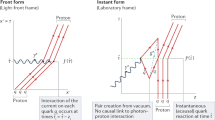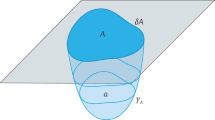Abstract
Replying to J. Ellis & N. E. Mavromatos Nature 479, doi:10.1038/nature10619 (2011)
In a previous paper1, I used the gauge-invariant background-field method to calculate a contribution to the renormalization of electric charge due to quantum gravity that was quadratically dependent on an energy cut-off. This was done by taking a constant electromagnetic background field, F. The result was used to support the original suggestion of Robinson and Wilczek2 that quadratic divergences could lead to asymptotic freedom. This result has been criticized by Ellis and Mavromatos3 and their present submission4 gives a shortened and altered discussion of their viewpoint.
Similar content being viewed by others
Main
The implication of Ellis and Mavromatos4 is that the quadratic divergence that I found1 is related to the dimension-six operator F∂2F. This is not the case. The quadratic divergence proportional to F2 that was calculated has nothing to do with F∂2F. I agree with these authors that the coefficient of F∂2F can be altered by a field redefinition and cannot affect any physically measurable quantity; by taking F to be constant as I did, the dimension-six operator cannot occur. What Ellis and Mavromatos4 argue is that the dimension-six operator cannot affect the renormalization (and hence running) of charge, and nothing more; their criticism has no direct bearing on the calculations reported by Robinson and Wilczek2 or myself1.
The reason why I do not now believe that the quadratic divergences contribute to a running electric charge has to do with not properly identifying a physically measurable definition of the charge. (I am grateful to J. Donoghue (personal communication) for pointing this out.) This should indeed follow from an S-matrix calculation but no one, including Ellis and Mavromatos, has attempted this calculation for Einstein–Maxwell (or Yang–Mills) theory. (A related S-matrix calculation has been done5 for a non-gauge field.) Instead the background-field method in one form or another has been used. A physical definition of charge can be considered completely within the background-field method where it can be shown6 that the quadratic divergences do not contribute to the running electric charge, and only logarithmic divergences do so contribute. Although it does not appear that the quadratic divergences lead to a running of gauge coupling constants, it is still possible7 that quantum gravity can lead to asymptotic freedom if there is a positive cosmological constant; however, the running is only logarithmic, not quadratic, and is not as interesting phenomenologically.
References
Toms, D. J. Quantum gravitational contributions to quantum electrodynamics. Nature 468, 56–59 (2010)
Robinson, S. P. & Wilczek, F. Gravitational correction to running of gauge couplings. Phys. Rev. Lett. 96, 231601 (2006)
Ellis, J. & Mavromatos, N. E. On the interpretation of gravitational corrections to gauge couplings. Preprint at 〈http://arXiv.org/abs/1012.4353〉 (2010)
Ellis, J. & Mavromatos, N. E. Does gravity correct gauge couplings? Nature 479, doi:10.1038/nature10619 (this issue).
Anber, M. M., Donoghue, J. F. & El-Houssieny, M. Running couplings, and operator mixing in the gravitational corrections to coupling constants. Phys. Rev. D 83, 124003 (2011)
Toms, D. J. Quadratic divergences and quantum gravitational contributions to gauge coupling constants. Phys. Rev. D 84, 084016 (2011)
Toms, D. J. Cosmological constant and quantum gravitational corrections to the running fine structure constant. Phys. Rev. Lett. 101, 131301 (2008)
Author information
Authors and Affiliations
Corresponding author
Rights and permissions
About this article
Cite this article
Toms, D. Toms replies. Nature 479, E6 (2011). https://doi.org/10.1038/nature10620
Published:
Issue Date:
DOI: https://doi.org/10.1038/nature10620
Comments
By submitting a comment you agree to abide by our Terms and Community Guidelines. If you find something abusive or that does not comply with our terms or guidelines please flag it as inappropriate.



